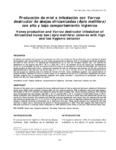
Please use this identifier to cite or link to this item:
http://ricaxcan.uaz.edu.mx/jspui/handle/20.500.11845/886Full metadata record
| DC Field | Value | Language |
|---|---|---|
| dc.contributor | 111167 | es_ES |
| dc.creator | Medina Flores, Carlos Aurelio | - |
| dc.creator | Guzmán Novoa, Ernesto | - |
| dc.creator | Aréchiga Flores, Carlos Fernando | - |
| dc.creator | Gutiérrez Bañuelos, Héctor | - |
| dc.creator | Aguilera Soto, Jairo Iván | - |
| dc.date.accessioned | 2019-03-28T16:13:23Z | - |
| dc.date.available | 2019-03-28T16:13:23Z | - |
| dc.date.issued | 2014-01-07 | - |
| dc.identifier | info:eu-repo/semantics/publishedVersion | es_ES |
| dc.identifier.issn | 2448-6698 | es_ES |
| dc.identifier.uri | http://localhost/xmlui/handle/20.500.11845/886 | - |
| dc.description | The aim of this study was to compare the honey yields and levels of Varroa destructor between colonies of Africanized honey bees (AHB) (Apis mellifera) showing high and low hygienic behavior (HB) in Mexico’s semi-arid high plateau. The degree of HB of 57 colonies was measured using the liquid nitrogen (N 2 ) brood-freezing technique. The colonies were categorized into two groups: high HB (> 95 %) and low HB (< 50 % removal of freeze-killed brood at 48 h). Honey production was evaluated in fall and spring and the level of Varroa on adult bees was determined before and during the honey harvests. The colonies with high HB produced significantly more honey than the colonies with low HB only during the spring crop (21.4 ± 4.7 vs 13.4 ± 5.0 kg; P<0.01). There were no significant differences between the two groups of colonies for levels of infestation by V. destructor (P>0.05). These results suggest that apparently HB does not have a major role in restraining the growth of Varroa populations in AHB. They also suggest that high levels of HB could contribute to increase honey production in AHB colonies during times of the year with limited nectar flow. | es_ES |
| dc.description.abstract | El objetivo del estudio fue comparar la producción de miel y los niveles de Varroa destructor entre colonias de abejas africanizadas (AA) (Apis mellifera) con alto y bajo comportamiento higiénico (CH) en el altiplano semiárido de México. Se midió el nivel de CH a 57 colonias por congelamiento de la cría con nitrógeno líquido (N 2 ). Las colonias se clasificaron en dos grupos: alto CH (> 95 %) y bajo CH (< 50 % de remoción de la cría muerta por congelamiento en 48 h). La producción de miel se evaluó durante el otoño y la primavera y el nivel de infestación por Varroa en abejas adultas se determinó antes y durante las cosechas de miel. En primavera, las colonias con CH alto produjeron significativamente más miel que las de CH bajo (21.4 ± 4.7 vs 13.4 ± 5.0 kg; P<0.01). No hubo diferencias entre los dos grupos de colonias para los niveles de Varroa (P>0.05). Estos resultados sugieren que aparentemente el comportamiento higiénico no tiene un efecto mayor en la resistencia de las AA al crecimiento poblacional del ácaro. También sugieren que el comportamiento higiénico alto podría contribuir a incrementar la producción de miel en épocas del año con flujo reducido de néctar. | es_ES |
| dc.language.iso | spa | es_ES |
| dc.publisher | Instituto Nacional de Investigaciones Forestales, Agrílas y Pecuarias | es_ES |
| dc.relation.uri | generalPublic | es_ES |
| dc.rights | Atribución-NoComercial-CompartirIgual 3.0 Estados Unidos de América | * |
| dc.rights.uri | http://creativecommons.org/licenses/by-nc-sa/3.0/us/ | * |
| dc.source | Revista Mexicana de Ciencias Pecuarias, Rev Mex Cienc Pecu HIGIÉNICO 2014;5(2):157-170 | es_ES |
| dc.subject.classification | CIENCIAS AGROPECUARIAS Y BIOTECNOLOGIA [6] | es_ES |
| dc.subject.other | Abejas melíferas | es_ES |
| dc.subject.other | Comportamiento higiénico | es_ES |
| dc.subject.other | Varroosis | es_ES |
| dc.subject.other | Tolerancia | es_ES |
| dc.subject.other | Cosecha de miel | es_ES |
| dc.subject.other | Honey bee | es_ES |
| dc.subject.other | Hygienic behavior | es_ES |
| dc.subject.other | Varroosis | es_ES |
| dc.subject.other | Tolerance | es_ES |
| dc.subject.other | Honey harvest | es_ES |
| dc.title | Producción de miel e infestación con Varroa destructor de abejas africanizadas (Apis mellifera) con alto y bajo comportamiento higiénico | es_ES |
| dc.title.alternative | Honey production and Varroa destructor infestation of Africanized honey bee (Apis mellifera) colonies with high and low hygienic behavior | es_ES |
| dc.type | info:eu-repo/semantics/article | es_ES |
| Appears in Collections: | *Documentos Académicos*-- UA Veterinaría | |
Files in This Item:
| File | Description | Size | Format | |
|---|---|---|---|---|
| Medina-Flores et al 2014 Rev Mex Cienc Pec.pdf | 109,78 kB | Adobe PDF |  View/Open |
This item is licensed under a Creative Commons License
